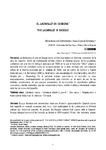El Lazarillo en euskera

Use este enlace para citar
http://hdl.handle.net/2183/27517
Excepto si se señala otra cosa, la licencia del ítem se describe como Atribución-NoComercial-CompartirIgual 4.0 Internacional
Metadatos
Mostrar el registro completo del ítemTítulo
El Lazarillo en euskeraTítulo(s) alternativo(s)
The Lazarillo in BasqueFecha
2020Cita bibliográfica
Ibarluzea Santisteban, Miren y Elizalde Estenaga, Amaia (2019). “El Lazarillo en euskera”. En Pilar Couto-Cantero, Rocío Chao-Fernández, Alfredo Rodríguez López-Vázquez & Arturo Rodríguez López-Abadía (eds.). Actas del Simposio del Lazarillo (A Coruña, 10-11 de octubre de 2019) (=Cursos_congresos_simposios; 148). A Coruña: Universidade da Coruña, pp. 61-68. DOI: https://doi.org/10.17979/spudc.9788497497657.61
Resumen
[Resumen] La literatura y el cine en lengua vasca se han reapropiado en diversas ocasiones de la obra del Lazarillo, dando así continuación al texto clásico en distintas épocas. En la actualidad, contamos con una versión bilingüe publicada en 1929 en la que el traductor “Orixe” adapta y reescribe tanto en castellano como en euskera pasajes de la obra, también con una reedición crítica de la misma publicada por A. Zelaieta en 1984, con un cómic de Cornejo y Fuente traducido por J. A. Berriotxoa (1990) y, finalmente, con una adaptación cinematográfica del 2012 dirigida por J. Berasategi. En el presente trabajo comentamos el recorrido de esas reapropiaciones, contextualizando su publicación para entender así la razón de ser de las distintas adaptaciones, de sus pasajes censurados, de la inserción de ingredientes gráficos concretos y demás elementos que las caracterizan y hacer visible el diálogo intertextual creado entre las versiones del Lazarillo. [Abstract] Basque literature and cinema have made use of and re-appropriated the Spanish classic text Lazarillo on several occasions and, thus, have participated in its continuation in different cultural and historical contexts. At present, the Basque cultural field counts with a Spanish-Basque bilingual version of the Lazarillo published in 1929 in which "Orixe", the translator, adapts and rewrites some passages of the work both in Spanish and Basque. We also count with a critical reedition of the aforementioned version published by A. Zelaieta in 1984, as well as with a comic created by Cornejo y Fuente and translated into Basque by J. A. Berriotxoa (1990). Finally, we count with a cinematographic adaptation of 2012 by J. Berasategi. In this short essay we comment on all those versions of the Lazarillo, contextualizing their publication in order to understand why their authors created those versions and the reasons for the adaptations, censored passages, specific graphic ingredients or other elements that characterize the versions and make visible the intertextual dialogue created among the versions of the Lazarillo.
Palabras clave
Literatura vasca
Literatura infantil y juvenil
Cine vasco
Adaptaciones y traducciones didácticas de clásicos
Censura
Basque literatura
Children’s literatura
Basque cinema
Didactic adaptations and translations of classics
Censorship
Literatura infantil y juvenil
Cine vasco
Adaptaciones y traducciones didácticas de clásicos
Censura
Basque literatura
Children’s literatura
Basque cinema
Didactic adaptations and translations of classics
Censorship
Versión del editor
Derechos
Atribución-NoComercial-CompartirIgual 4.0 Internacional
ISBN
978-84-9749-765-7






